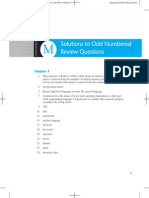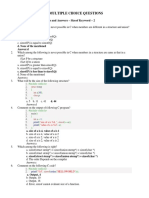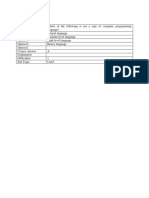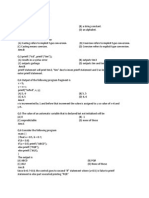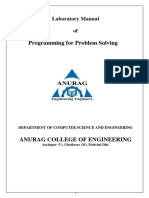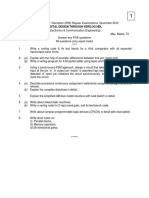C++ Chapter 1 - 6
C++ Chapter 1 - 6
Uploaded by
Jose Silvas CoronaCopyright:
Available Formats
C++ Chapter 1 - 6
C++ Chapter 1 - 6
Uploaded by
Jose Silvas CoronaOriginal Description:
Original Title
Copyright
Available Formats
Share this document
Did you find this document useful?
Is this content inappropriate?
Copyright:
Available Formats
C++ Chapter 1 - 6
C++ Chapter 1 - 6
Uploaded by
Jose Silvas CoronaCopyright:
Available Formats
Starting Out With C++: Early Objects, Fifth Edition Solutions to Review Questions Chapter 1 1. programmed 2. CPU 3.
arithmetic logic unit (ALU) and control unit 4. disk drive 5. operating systems and application software 6. instructions 7. programming language 8. Machine language 9. High-level 10. Low-level 11. portability 12. key 13. programmer-defined symbols 14. Operators 15. Punctuation 16. syntax 17. variable 18. defined (or declared) 19. input, processing, output 20. Input 21. Output 22. hierarchy chart
23. Main memory, or RAM, is volatile, which means its contents are erased when power is removed from the computer. Secondary memory, such as a disk or CD, does not lose its contents when power is removed from the computer. 24. An operating system is a set of programs that manages the computer's hardware devices and controls their processes. Application software are programs that users use to solve specific problems or perform general operations. 25. A syntax error is the misuse of a key word, operator, punctuation, or other part of the programming language. A logical error is a mistake that tells the computer to carry out a task incorrectly or to carry out tasks in the wrong order. It causes the program to produce the wrong results. 26. Hierarchy Chart:
Calculate Customer's Available Credit
Get Inputs
Calculate and Display Available Credit
Read Max Credit
Read Credit Used
27. Account Balance High Level Pseudocode
Have user input starting balance Have user input total deposits Have user input total withdrawals Calculate current balance Display current balance Account Balance Detailed Pseudocode Input startBalance // with prompt Input totalDeposits // with prompt Input totalWithdrawals // with prompt currentBalance = startBalance + totalDeposits - totalWithdrawals Display currentBalance
28. Sales Tax High Level Pseudocode
Have user input retail price Have user input sales tax rate Calculate tax amount Calculate sales total Display tax amount and sales total Sales Tax Detailed Pseudocode Input retailPrice // with prompt Input salesTaxRate // with prompt taxAmount = retailPrice * salesTaxRate salesTotal = retailPrice + taxAmount Display taxAmount, salesTotal
29. 30. 31. 32. 33.
45 7 28 365 The error is that the program performs its math operation before the user has entered values for the variables width and length.
34. Some of the questions that should be asked are: What standard ceiling height should be used, or is this figure to be input? How many square feet should be subtracted out for windows and doors, or do you also want this information input since it could vary by room? Are the ceilings also to be painted or just the walls? How many square feet will 1 gallon of paint cover? How many coats of paint will you use or should this information be input?
Chapter 2 1. semicolon 2. iostream 3. main 4. # 5. braces {} 6. constants, or literals 7. 9.7865E14 8. 1, 2
9. B 10. A, C 11. B (C is valid, but prints the contents of variable Hello, rather than the string Hello.) 12. B 13. A) 11 B) 14 C) 3 (An integer divide takes place.) 14. A) 9 B) 14 C) 2 15. double temp, weight, height; 16. int months = 2, days, years = 3; 17. A) B) C) D) E) 18. A) B) C) D) E) d2 = d1 + 2; d1 = d2 * 4; c = K; i = K; i = i 1; d1 = d2 8.5; d2 = d1 / 3.14; c = F; i = i + 1; d2 = d2 + d1; << << << << "Two mandolins like creatures in the\n\n\n"; "dark\n\n\n"; "Creating the agony of ecstasy.\n\n\n"; " - George Barker\n\n\n";
19. cout cout cout cout
20. cout << L\n << E\n << A\n << F\n; This can also be written as a single string literal: cout << L\nE\nA\nF\n;
21. Input weeks
days = weeks * 7 Display days
// with prompt
22. Input eggs
cartons = eggs / 12 Display cartons
// with prompt // perform integer divide
23. Input speed
// with prompt Input time // with prompt distance = speed * time Display distance // with prompt Input gallons // with prompt milesPerGallon = miles / gallons Display milesPerGallon
24. Input miles
25. A) 0 100 B) 8 2 C) I am the incrediblecomputing machine and I will amaze you. 26. A) Be careful! This might/n be a trick question. B) 23 1 27. The C-style comments symbols are backwards. iostream should be enclosed in angle brackets. There shouldn't be a semicolon after int main(). The opening and closing braces of function main are reversed. There should be a semicolon after int a, b, c. The comment \\ Three integers should read // Three integers. There should be a semicolon at the end of each of the three assignment statements. cout begins with a capital letter. The stream insertion operator (that appears twice in the cout statement) should read << instead of <. The cout statement uses the variable C instead of c.
28. Whatever problem a pair of students decides to work with they must determine such things as which values will be input vs. which will be set internally in the program, how much precision is required on calculations, what output will be produced by the program, and how it should be displayed. Students must also determine how to handle situations that are not clear cut. In the paint problem many of these considerations are listed in the teacher answer key (Chapter 1, Question 34). In the recipe program students must determine such things as how to handle quantities, like one egg, that cannot be halved. In the driving program, knowing distance and speed are not enough. Agreement should be reached on how to handle delays due to traffic lights and traffic congestion. Should this be an input value, computed as a percent of overall driving time, or handled some other way?
Chapter 3 1. A) cin >> description; B) getline(cin, description); 2. char name[35]; 3. A) cin >> setw(25) >> name; B) cin.getline(name, 25); 4. cin >> age >> pay >> section; 5. iostream and iomanip 6. char city[31]; 7. A) price = 12 * unitCost; B) cout << setw(12) << 98.7; C) cout << 12; 8. 5, 22, 20, 6, 46, 30, 0, 3, 16 9. A) B) C) D) E) a z y g c = = = = = 12 * x; 5 * x + 14 * y + 6 * k; pow(x, 4); (h + 12) / (4 * k); pow(a, 3) / (pow(b, 2) * pow(k, 4));
10. Two implicit data type conversions occur. First, because mass is a float, a copy of the int value stored in units is promoted to a float before the multiplication operation is done. The result of mass * units will be a float. The second data type conversion occurs when the float result is promoted to a double in order to be stored in double variable weight.
11. 8 12. Either of these will work: unitsEach = static_cast<double>(qty) / salesReps; unitsEach = qty / static_cast<double>(salesReps); 13. const int RATE = 12; 14. x += 5; total += subtotal; dist /= rep; ppl *= period; inv -= shrinkage; num %= 2; 15. east = west = north = south = 1; 16. int sum = 0; 17. No, a named constant must be initialized at the time it is defined. It cannot be assigned a value at a later time. 18. cout << fixed << showpoint << setprecision(2); cout << setw(8) << divSales; 19. cout << fixed << showpoint << setprecision(4); cout << setw(12) << profit; 20. A) cmath B) fstream C) iomanip
Note: Once students understand that inputs from the keyboard should always be preceded by prompts, the // with prompt comment can be omitted from the pseudocode. Therefore, beginning with Chapter 3, we no longer include it. 21. Input score1
Input score2 Input score3 average = (score1 + score2 + score3) / 3.0 Display average
22. discountPct = .15
Input salesAmt amtSaved = salesAmt * discountPct amtDue = salesAmt amtSaved Display amtSaved, amtDue
23. Input maxCredit
Input creditUsed availableCredit = maxCredit creditUsed Display availableCredit
24. PI = 3.14
PRICE_PIZZA12 = 12.00 PRICE_PIZZA14 = 14.00 areaPizza12 = PI * (12 / 2)2 areaPizza14 = PI * (14 / 2)2 pricePerSqIn12 = PRICE_PIZZA12 / areaPizza12 pricePerSqIn14 = PRICE_PIZZA14 / areaPizza14 Display pricePerSqIn12, pricePerSqIn14
25. A) Your monthly wages are 3225 // Some compilers B) 6 3 12 C) In 1492 Columbus sailed the ocean blue. 26. A) Hello George B) Hello George Washington C) Minutes: 612002.0000 Hours: 10200.0332 Days: 425.0014 Months: 13.9726 Years: 1.1644
display 3225.0000
27. A) #include <iostream> is missing. Each cin and cout statement starts with capital C. The << operator is mistakenly used with cin. The assignment statement should read: sum = number1 + number2; The last cout statement should have << after cout and should end with a semi-colon. The body of the main function should be indented within the braces. B) The cin statement should read: cin >> number1 >> number2; The assignment statement should read: quotient = static_cast<double>(number1) / number2; The last cout statement is missing a semicolon. There is no return 0;
28. A) The variables should not be declared const. The last cout statement is missing a semicolon. B) There shouldnt be a semicolon after the #include directive. The function header for main should read: int main() The combined assignment operators are improperly used. Those statements should be: number1 *= 50; number2 *= 50; There is no return 0; 29. A) There shouldnt be a semicolon after the #include directive. The function header for main should read: int main() The variable number is defined, but it is called number1 in the cin statement. The combined assignment operator is improperly used. The statement should read: half /= 2; There is a logical error. The value divided by 2 should be number, not half. The results are never output. There is no return 0; B) There shouldnt be a semicolon after the #include directive. name should be declared as a string or a char array. If declared as string, a #include <string> directive is needed. The statement cin.getline >> name; should read cin >> name; The statement cin >> go; should read cin.get(go); 30. Before the price per square inch of a pizza can be calculated, we need to know both the number of square inches it contains and its price. The price for each size pizza can be set at the beginning of the program as constants, since they are known. This can also be done with PI, which is needed for the pizza area calculation. We will use 3.14 for PI because that is precise enough for our calculations. The area of each pizza can be calculated with the formula area = PI * radius2, where the radius of each pizza is half of its diameter. Now that the price of each pizza and its area are known, the price per square inch for each pizza can be found by dividing the price by the area. If you are unsure what to divide by what to get the answer, try thinking of a simple example using actual numbers. Suppose a pizza contained only 12 square inches and cost $12.00, then it would cost 12 / 12 or $1.00 per square inch. But if it were twice that big for the same price, it would only cost half as much per square inch. Right? Since 24/12 = $2.00 per square inch, that cant be right. But 12 / 24 = $ .50 per square inch. That is clearly correct. So you can see that we need to divide the price by the square inches to get the correct result.
Chapter 4 1. relational 2. false, true 3. false, true 4. braces 5. true, false 6. default 7. false 8. true 17. if (y == 0) x = 100; 18. if (y == 10) x = 0; else x = 1; 19. if (score >= 90) cout << Excellent; else if (score >= 80) cout << Good; else cout << Try Harder; 20. if (minimum) hours = 10; 21. if(x < y) q = a + b; else q = x * 2; 22. switch (choice) { case 1: cout << break; case 2: case 3: cout << break; case 4: cout << break; default: cout << break; } 9. ! 10. lower 11. && 12. || 13. block (or local) 14. integer 15. break 16. 1, 0, 0, 1
fixed << showpoint << setprecision(2);
fixed << showpoint << setprecision(4); fixed << showpoint << setprecision(6); fixed << showpoint << setprecision(8);
23. T, F, T 24. T, F, T 25. if (grade >= 0 && grade <= 100) cout << "The number is valid."; 26. if (temperature >= -50 && temperature <= 150) cout << "The number is valid."; 27. if (hours < 0 || hours > 80) cout << "The number is not valid."; 28. When using string objects, use the following code: if(title1 <= title2) cout << title1 << " " << title2 << endl; else cout << title2 << " " << title1 << endl; With using C-strings, you must replace the above if statement with: if (strcmp(title1, title2) <= 0) 29. if(sales < 10000) commission = .10; else if (sales <= 15000) commission = .15; else commission = .20; 30. There are several correct ways to write this. Here is one way. if(dept == 5 && price >= 100) discount = .20; else if (price >= 100) // but dept is not 5 discount = .15; else if(dept == 5) // but price < 100 discount = .10; else // dept is not 5 and price < 100 discount = .05; 31. It should read if (!(x > 20)) 32. It should use && instead of ||. 33. It should use || instead of &&. 34. The statement will always be true. It x equals neither 1 nor 2, it is clearly true. If x equals 1 it is true because x != 2 is true. If x equals 2 it is true because x != 1 is true. The statement should use && instead of ||.
35. A) The first cout statement is terminated by a semicolon too early. The definition of score1, score2, and score3 should end with a semicolon. The statement: if(average = 100) should read: if(average == 100) perfectScore is used before it is declared. The if (perfectScore); statement should not be terminated with a semicolon. The conditionally-executed block in the if statement shown above should end with a closing brace. B) The conditionally-executed blocks in the if/else construct should be enclosed in braces. The statement cout << The quotient of << num1 << should end with a semi-colon, rather than with a <<. C) The trailing else statement should come at the end of the if/else construct. D) A switch case construct cannot be used to test relational expressions. An if/else if statement should be used instead. 36. A) An if/else if is more appropriate than a switch statement when all test expressions do not involve the same variable or when test expressions need to test more than one condition, work with non-integer values, or use relational operators that test for something other than equality. B) A switch statement is more appropriate than an if/else if statement when all tests are comparing a variable for equality with just 1 or a small set of integer values. It is a particularly useful construct to use when you want to utilize the fall through feature to carry out more than 1 set of actions when a particular condition is true. C) A set of nested if/else statements is more appropriate than either of the other two constructs when the test conditions that determine the actions to be carried out do not fall into a neat set of mutually exclusive cases. For example, if one condition is true, then which set of actions you wish to take may depend on the outcome of a second test.
Chapter 5 1. increment 2. decrement 3. prefix 4. postfix 5. body 6. iteration 7. pretest 8. posttest loop 9. infinite (or endless) 10. counter 21. int num; cin >> num; num *=2; while (num < 50) { cout << num << endl; num *=2; } 22. do { float num1, num2; char again; cout cin cout cout cin } while << "Enter two numbers: "; >> num1 >> num2; << "Their sum is " << (num1 + num2) << endl; << "Do you wish to do this again? (Y/N) "; >> again; (again == 'Y' || again == 'y'); 11. running total 12. accumulator 13. sentinel 14. for 15. do-while 16. while and for 17. initialization, test, update 18. nested 19. break 20. continue
23. for (int x = 0; x <= 1000; x += 10) cout << x; 24. float total, num; for (int count = 0; count < 10; count++) { cout << "Enter a number: "; cin >> num; total += num; }
25. for (int row = 1; row <= 3; row++) { for (int star = 1; star <= 5; star++) cout << *; cout << endl; } 26. for (int row = 0; row < 10; row++) { for (int col = 0; col < 15; col++) cout << #; cout << endl; } 27. char doAgain; int sum = 0; cout << "This code will increment sum 1 or more times.\n"; do { sum++; cout << "Sum has been incremented. << Increment it again(y/n)? "; cin >> doAgain; } while (doAgain == 'y' || doAgain == 'Y'); cout << "Sum was incremented " << sum << " times.\n"; 28. int number; cout << "Enter an even number: "; cin >> number; while (number % 2 != 0) { cout << "Number must be even. Reenter number: "; cin >> number; } 29. for (int count = 0; count < 50; count++) cout << "count is " << count << endl; 30. int x = 50; while (x > 0) { cout << x << seconds to go.\n; x--; } 31. Nothing will print. The erroneous semicolon after the while condition causes the while loop to end there. Because x will continue to remain 1, x < 10 will remain true and the infinite loop can never be exited. 32. 10. Because there are no braces only the x++ statement is in the body of the loop.
33. 2 4 6 8 10 34. $9999 $9999 $9999 35. A) The statement result = ++(num1 + num2); is invalid. B) The while loop tests the variable again before any values are stored in it. The while loop is missing its opening and closing braces. 36. A) The while statement should not end with a semicolon. It could also be argued that BigNum should be declared a long int. B) The variable total is not initialized to 0. 37. A) The expression tested by the do-while loop should be choice == 1 instead of choice = 1. B) The variable total is not initialized to 0. The while loop does not change the value of count, so it iterates an infinite number of times.
Chapter 6 1. header 2. void 3. showValue(5); 4. definition, prototype 5. arguments 6. parameters 7. value 8. prototype 9. local 10. Global 11. Global 12. 0 13. local 14. Static 15. return 16. Default 17. last 18. literal or constant 19. reference 20. & 21. reference 22. exit 23. parameter lists
24. Each function can handle one small, manageable task. This makes it easier to design, code, test, and debug. 25. Arguments appear in the parentheses of a function call. They are the actual values passed to a function. Parameters appear in the parentheses of a function heading. They are the variables that receive the arguments. 26. yes 27. Function overloading means including more than one function in the same program that has the same name. C++ allows this providing the overloaded functions can be distinguished by having different parameter lists. 28. Pass it by value. 29. You want the function to change the value of a variable that is defined in the calling function. 30. with a return statement. 31. Yes, but within that function only the local variable can be seen and accessed. 32. Use a static variable when you need a local variable to retain its value between function calls. 33. double half(double value) { return value / 2; } 34. result = cube(4); 35. void timesTen(int num) { cout << num * 10; } 36. display(age, income, initial);
37. void getNumber(int &number) { cout << Enter an integer between 1 and 100): ; cin >> number; while (number < 1 || number > 100) { cout << This value is out of the allowed range.\n << Enter an integer between 1 and 100): ; } } 38. int biggest(int num1, int num2, int num3) { if (num1 >= num2 && num1 >= num3) return num1; if (num2 >= num3) return num2; return num3; } 39. A) The data type of value2 and value3 must be declared. The function is declared void but returns a value. B) The assignment statement should read: average = (value1 + value2 + value3) / 3.0; The function is declared as a double but returns no value. C) width should have a default argument value. The function is declared void but returns a value. D) The parameter should be declared as: int &value The cin statement should read: cin >> value; E) The functions must have different parameter lists.
You might also like
- Checkpoint AnswersDocument28 pagesCheckpoint AnswersKristin Dikiciyan50% (4)
- Starting Out With C++: Early Objects, Tenth Edition Solutions To End-of-Chapter Review QuestionsDocument2 pagesStarting Out With C++: Early Objects, Tenth Edition Solutions To End-of-Chapter Review QuestionsMohamed AbdoNo ratings yet
- COM142 - C Programming Final ExamDocument10 pagesCOM142 - C Programming Final ExamPipin FitriadiNo ratings yet
- C++ Proposed Exercises (Chapter 8: The C++ Programing Language, Fourth Edition) - SolutionDocument6 pagesC++ Proposed Exercises (Chapter 8: The C++ Programing Language, Fourth Edition) - SolutionMauricio Bedoya25% (4)
- Answers To Checkpoints QuestionsDocument35 pagesAnswers To Checkpoints QuestionsparesarebNo ratings yet
- C++ SolutionsDocument30 pagesC++ SolutionsRodney LucasNo ratings yet
- C Prog Sample ProblemsDocument2 pagesC Prog Sample ProblemsBryan EduriaNo ratings yet
- Python - Final Exam by Ethio ExamsDocument13 pagesPython - Final Exam by Ethio ExamsHENOK GIRMANo ratings yet
- Lab 2Document6 pagesLab 2Vijay KumarNo ratings yet
- Programs For Printing Pyramid Patterns in C++ - GeeksforGeeksDocument12 pagesPrograms For Printing Pyramid Patterns in C++ - GeeksforGeeksHassanNo ratings yet
- OOP - Tieng AnhDocument114 pagesOOP - Tieng AnhVo Hoai NamNo ratings yet
- Assembly Language For x86 ProcessorsDocument9 pagesAssembly Language For x86 ProcessorsSheri & WaqasNo ratings yet
- C Multiple Choice QuestionsDocument13 pagesC Multiple Choice QuestionsmcaviimsNo ratings yet
- MCQ FunctionDocument13 pagesMCQ FunctionMahesh Chandra UpadhyayNo ratings yet
- MCQ (Revision Tour, Functions and File Handling) With SolutionDocument52 pagesMCQ (Revision Tour, Functions and File Handling) With SolutionsureshNo ratings yet
- Solution of Quiz 3Document5 pagesSolution of Quiz 3Pranavkumar PatilNo ratings yet
- CDocument166 pagesChossein_eskandarNo ratings yet
- Part 1 Summary Test Modulo 1-2-3-4Document8 pagesPart 1 Summary Test Modulo 1-2-3-4Leonardo PasqualeNo ratings yet
- Programming Fundamentals (Composition Relationship)Document3 pagesProgramming Fundamentals (Composition Relationship)Arslan SohailNo ratings yet
- Unit 3 MCQDocument61 pagesUnit 3 MCQAjay JachakNo ratings yet
- Computer Science Practical FileDocument19 pagesComputer Science Practical FileRaj VermaNo ratings yet
- Figure 1. String Activity 1 FlowchartDocument25 pagesFigure 1. String Activity 1 FlowchartThrowaway TwoNo ratings yet
- Parameters: Chapter Eighteen Modern Programming Languages 1Document49 pagesParameters: Chapter Eighteen Modern Programming Languages 1soundarpandiyanNo ratings yet
- Lab Manual # 08: Title: Arrays in C++ One D ArrayDocument18 pagesLab Manual # 08: Title: Arrays in C++ One D ArrayUsama SagharNo ratings yet
- Cse MCQ For Engineering 1st YearDocument21 pagesCse MCQ For Engineering 1st YearMohd Amir0% (1)
- Object Oriented Programming Using C++ Second Year Sem II: Two Marks QuestionsDocument6 pagesObject Oriented Programming Using C++ Second Year Sem II: Two Marks QuestionsShubhendu Shekhar100% (1)
- C Programming NotesDocument96 pagesC Programming NotesNgatia MukereNo ratings yet
- C ProgrammingDocument56 pagesC ProgrammingHaritha rajeswari1810No ratings yet
- L6 - Intermediate Code GenerationDocument56 pagesL6 - Intermediate Code GenerationIQRA Talim ClassNo ratings yet
- C Language MCQ Bank PDFDocument11 pagesC Language MCQ Bank PDFbheemsinghsaini0% (1)
- CprogrammingDocument32 pagesCprogrammingBhanupriya ChoukseyNo ratings yet
- C Programming Interview Questions PDF DownloadDocument6 pagesC Programming Interview Questions PDF DownloadcourpediaNo ratings yet
- MCQ's On Files and Streams: #Include #IncludeDocument9 pagesMCQ's On Files and Streams: #Include #IncludePrasad MahajanNo ratings yet
- M3 R5 Python MCQDocument7 pagesM3 R5 Python MCQvikaskumar4430No ratings yet
- The Tree ADTDocument42 pagesThe Tree ADTnajiullah khanNo ratings yet
- CPL Week1Document9 pagesCPL Week1nallamalli sushma100% (1)
- موسوعة امثلة C++ المحلولةDocument34 pagesموسوعة امثلة C++ المحلولةRay AlNo ratings yet
- Question Bank - EC-208 - Programming ConceptsDocument20 pagesQuestion Bank - EC-208 - Programming ConceptsPiyush CharanNo ratings yet
- Function in CDocument12 pagesFunction in CGoldy Batra100% (1)
- CS-100-QP2-Solved-KTU Notes PDFDocument44 pagesCS-100-QP2-Solved-KTU Notes PDFRekha V R100% (1)
- QuestionsDocument2 pagesQuestionsNJUGO MCHUNJUGO100% (1)
- C QuestionsDocument12 pagesC QuestionsSivaprakasam KarthikeyanNo ratings yet
- If, If..else Statement in Java With ExamplesDocument3 pagesIf, If..else Statement in Java With Examplesakhil100% (1)
- Microsoft - Selftestengine.98 381.v2018!10!10.by - Bobby.22qDocument36 pagesMicrosoft - Selftestengine.98 381.v2018!10!10.by - Bobby.22qMuhammad Saad AshrafiNo ratings yet
- 11Document13 pages11Manish MadhavNo ratings yet
- C Programming Questions and AnswersDocument18 pagesC Programming Questions and AnswerschitranshpandeyNo ratings yet
- PPS Lab ManualDocument72 pagesPPS Lab ManualRAJESHNo ratings yet
- C QuestionsDocument4 pagesC QuestionsGohoNo ratings yet
- Quiz 15 NovDocument4 pagesQuiz 15 NovMuhammad Ali100% (1)
- Introduction To Programming in C++ Summer II 2002: Midterm TestDocument13 pagesIntroduction To Programming in C++ Summer II 2002: Midterm TestIshan JawaNo ratings yet
- 101 Programs by KodegodDocument64 pages101 Programs by KodegodSumit ChakrabortyNo ratings yet
- C Programs ExamplesDocument11 pagesC Programs Examplesganesh_krishnaNo ratings yet
- Boolean AlgebraDocument21 pagesBoolean AlgebrachinnarrrNo ratings yet
- 50 Important Questions of C LanguageDocument3 pages50 Important Questions of C LanguageRahulGupta73% (11)
- Chapter 1 Exam PDFDocument7 pagesChapter 1 Exam PDFEgy RenataNo ratings yet
- Introduction To Assembler Programming Cheat Sheet: Richard Cebula - HLASMDocument9 pagesIntroduction To Assembler Programming Cheat Sheet: Richard Cebula - HLASMTanjim Hossain SiamNo ratings yet
- MCQ Basics of CDocument20 pagesMCQ Basics of CRamesh KannanNo ratings yet
- Python Revision TourDocument10 pagesPython Revision TourSANTOSH KEKANENo ratings yet
- Projects With Microcontrollers And PICCFrom EverandProjects With Microcontrollers And PICCRating: 5 out of 5 stars5/5 (1)
- Application Note 2420 1-Wire Communication With A Microchip Picmicro MicrocontrollerDocument10 pagesApplication Note 2420 1-Wire Communication With A Microchip Picmicro Microcontrollervuquangbk0612No ratings yet
- Mca4a 08.04.2024Document1 pageMca4a 08.04.2024Pratik BoseNo ratings yet
- Telnet PDFDocument10 pagesTelnet PDFJhon ValenciaNo ratings yet
- Sdphison PS8032Document31 pagesSdphison PS8032alberto uribeNo ratings yet
- PBAP DataDocument8 pagesPBAP DataHarsh JainNo ratings yet
- Golf 6 and New Beetle 70F3427Document5 pagesGolf 6 and New Beetle 70F3427Angel A.No ratings yet
- Excel File OperationsDocument4 pagesExcel File Operationsk.shreenivas624No ratings yet
- Rollup Advanced Details Abinitio NotesDocument2 pagesRollup Advanced Details Abinitio NotesVivek KaushikNo ratings yet
- BW TrainingDocument44 pagesBW TrainingPhaniNo ratings yet
- Ec3352 Set3Document3 pagesEc3352 Set3menakadevieceNo ratings yet
- نسخة من Lecture 2.1 - Identify the History of ComputerDocument14 pagesنسخة من Lecture 2.1 - Identify the History of Computerوجدان الشداديNo ratings yet
- Client Side Scripting (CSS) (22519) Semester - V (CO) : A Laboratory Manual ForDocument45 pagesClient Side Scripting (CSS) (22519) Semester - V (CO) : A Laboratory Manual ForIsha RangariNo ratings yet
- Ecodial Advance Calculation: Live Update (Minor) Example: 4.8. 4.8Document8 pagesEcodial Advance Calculation: Live Update (Minor) Example: 4.8. 4.8benkhelilNo ratings yet
- VMware QuestnsDocument66 pagesVMware QuestnsShyamNo ratings yet
- Quick Start Guide: 2.4 Inch TFT Terminal Time Attendance & Access ControlDocument16 pagesQuick Start Guide: 2.4 Inch TFT Terminal Time Attendance & Access ControlDatashield InfoNo ratings yet
- Mobile Intel® 4 Series Express Chipset Family Graphics Memory Controller Hub (G) MCHDocument17 pagesMobile Intel® 4 Series Express Chipset Family Graphics Memory Controller Hub (G) MCHb1767572No ratings yet
- UntitledDocument14 pagesUntitledseng tanNo ratings yet
- The Black Screen of DeathDocument35 pagesThe Black Screen of DeathHeart WeyganNo ratings yet
- Health Check Up For ABAP SystemDocument3 pagesHealth Check Up For ABAP Systemrathish17100% (1)
- Lecture Notes Introduction To Programming Semester 2 2022Document129 pagesLecture Notes Introduction To Programming Semester 2 2022Bebo AkramNo ratings yet
- EWM CLASS 43 - RF - Sending Messages To Working ResourcesDocument6 pagesEWM CLASS 43 - RF - Sending Messages To Working ResourcesRaviteja KanakaNo ratings yet
- Setting Up The Application Core SlidesDocument58 pagesSetting Up The Application Core SlidesManehcmis ManeNo ratings yet
- Erwin API RefDocument195 pagesErwin API RefGustavo MendozaNo ratings yet
- 9A04706 Digital Design Through Verilog HDL PDFDocument4 pages9A04706 Digital Design Through Verilog HDL PDFTayyabunnissa BegumNo ratings yet
- Microprocessor Applications For ScientistDocument3 pagesMicroprocessor Applications For ScientistRam Kishore RoyNo ratings yet
- Service Note SN 015 - HFAdv - RevbDocument6 pagesService Note SN 015 - HFAdv - RevbAROGYA REDDYNo ratings yet
- Class5 Notes & Diagram Attachments SAP Ui5 Fiori Odata CDS CourseDocument3 pagesClass5 Notes & Diagram Attachments SAP Ui5 Fiori Odata CDS Courseanuradha agrawalNo ratings yet
- Online Examination Management System.Document28 pagesOnline Examination Management System.Kamal AcharyaNo ratings yet
- Autonomous Self-Parking RobotDocument10 pagesAutonomous Self-Parking RobotTsion NegussieNo ratings yet
- Blink AppDocument20 pagesBlink AppSugaina K.RNo ratings yet





